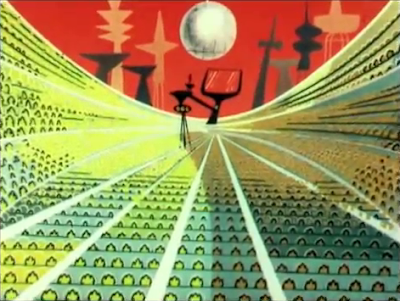Jeannie the babysitter can’t wait to gab on the phone in “Tot Watchers” (released August 1958). Her arm stretches in an Avery-like exaggeration and pulls her toward the phone. Look, folks! It’s a Cinemascope gag!
.png)
.png)
.png)
Tom gets a stretch job himself.
.png)
Below, Jeannie is in shock when she realises there’s no cord connecting the handset to the phone. Bill Hanna and Joe Barbera are already learning how to cut corners as they anticipate TV animation, although even the cheap Yogi Bear cartoons had a phone cord when needed.
.png)
This sorry cartoon brought to an end the Tom and Jerrys made on the Metro lot in Culver City. Ken Muse, Lew Marshall and Jim Escalante get the animation credits. The old Hanna-Barbera unit had pretty much broken up. Ed Barge (
Billboard, May 5, 1956) and Irv Spence (
Variety, Aug. 30, 1956) had left for commercial house Animation, Inc. Muse and Marshall would follow Hanna and Barbera to their own studio, Escalante was an effects animator who apparently went into the ministry.
Happy Homer Brightman received the screen credit for the story. The cartoon would have been started before July 18, 1956 as that’s when
Variety announced Walter Lantz had signed Brightman to an exclusive, five-year contract (Brightman had been freelancing the previous two years).
The voice actors on this cartoon are a little baffling, other than Bill Thompson pulls out his Irish accent to the play the sceptical cop (a staple stereotype in later Hanna-Barbera TV cartoons). No, Janet Waldo is not the voice of Jeannie. If I recall, voice historian Keith Scott said the babysitter was played by Louise Erickson, who (like Waldo) made a career playing squealing teenaged girls on network radio. The mother may be Perry Sheehan;
Variety reported on April 13, 1956 that she and Dick Anderson had been signed by MGM to supply voices for the suburbanite couple in the Tom and Jerry cartoon “The Vanishing Duck.”
.png)
.png)
.png)
.png)
.png)
.png)
.png)
.png)
.png)
.png)
.png)
.png)
.png)
.png)
.png)






.png)
.png)
.png)
.png)
.png)
.png)
.png)
.png)
.png)
.png)


.png)
.png)
.png)
.png)
.png)
.png)
.png)
.png)
.png)
.png)
.png)
.png)
.png)
.png)
.png)
.png)
.png)
.png)